0 Introduction
High-voltage circuit breakers are crucial equipment in power system [1,2],which play a significant role in the operation of substations and even the power grid.During operation,various types of faults may occur according to statistics from the Power Grid Conference,and mechanical faults are the main type of faults that affect the operation of high-voltage circuit breakers,accounting for over 80%of the faults [3,4].The maintenance of these mechanical parts consumes considerable time and energy of the operators and maintenance personnel.The traditional maintenance approach typically requires a power outage to facilitate circuit breaker maintenance,which incurs huge human and material costs and,to certain extent,reduces the safety margin of the power operation.The voiceprint signals generated during the operation of circuit breakers contain a large amount of operational information that can reflect various conditions of circuit breaker performance.Monitoring and analysis methods based on voiceprint information are widely utilized in circuit breaker fault diagnosis [5-7].
At present,most of the researches conducted focus on the possible single-fault type of circuit breakers [8-12],and there is less research conducted on possible multiple faults.The main difficulty lies in obtaining voiceprint information because circuit breakers have very few opening and closing operations,and it is difficult to obtain sufficient sample data (one solution is to build an experimental platform and use high-precision sensors).Another difficulty is to decompose and identify specific single faults from the voiceprint information of multiple faults (as multiple faults may contain mixed information of one,two,three,or even more single-fault permutations and combinations,there are great difficulties in feature extraction and fault diagnosis identification).Then,the fault type diagnosis of the circuit breaker is completed (one solution is to adopt appropriate methods to decompose multiple fault information into a single fault information,and extract effective features of the fault).During operation,if multiple faults occur in a highvoltage circuit breaker,the damage caused will be more severe than that caused by a single fault.Therefore,focusing on multiple faults that may occur in circuit breakers is of great significance for the safe and reliable operation of power systems.An important aspect of fault diagnosis is the effective fault feature extraction.It is extremely difficult to extract features directly from the voiceprint information of multiple faults,and at times,multiple faults contain different types of faults,which increases the difficulty of fault feature extraction and diagnostic identification.Therefore,when multiple faults are encountered,it is necessary to adopt another problem-solving analytical approach.First,multiple faults are decomposed into a single fault,and then feature extraction is performed on a single fault to complete the fault diagnosis,which is also the analytical approach of this study.
Recently,in the field of mechanical engineering,researchers have proposed monitoring and identification analyses for multiple faults [13-16].For mechanical bearings,Reference [13] provided a method of component reconstruction that decomposes the obtained mechanical vibration signals and introduced the Bancang Saito distance method to decompose the vibration signal information of multiple faults and complete fault feature extraction.Reference [14] provided a method for empirical mode decomposition that uses the number of mutual relationships as an indicator to complete the feature decomposition of multiple faults in mechanical bearings.Reference[17] provided a method for ensemble empirical mode decomposition components that utilizes independent component analysis to achieve component decomposition of multiple fault signals in mechanical bearings.Modal decomposition methods exhibit modal aliasing and endpoint effects,and their diagnostic performance is affected by the selected component signals.The decomposed components may contain multiple faulty components.The use of a single indicator for component selection often leads to inaccurate selection results,and can easily lead to multiple fault identification errors or omissions.Reference [18]analyzed a recursive quantization identification method for circuit breaker vibration signals,mainly by studying the fault states of spring structures.Reference [19] considered incorporating the features extracted from vibration and current signals into a feature set to identify the operating status of circuit breakers.Reference [20] provided a neural network algorithm for the fault diagnosis of the operating mechanism of high-voltage circuit breakers.
Multiple-fault information consisting of multiple components was studied using component decomposition techniques.Common methods include wavelet,empirical mode,sparse component,and variational mode decompositions.The non-negative matrix decomposition method,originally developed by D D.Lee and H.S.Sueng [21],offers the advantages of a clear calculation process,relatively simple implementation,and decomposition results with clear physical significance.It has been gradually applied to signal decomposition problems in the engineering field [22];however,its utilization in the fault diagnosis of high-voltage circuit breakers remains relatively rare.
Based on the above discussion and analysis,to solve the problem of multiple mechanical faults that may occur in high-voltage circuit breakers and the shortcomings in diagnosis,according to the characteristics of mechanical faults in circuit breakers,this study applies the theory of non-negative matrix decomposition to provide a multi-fault identification method.First,the sound pattern data of the opening and closing of the circuit breaker were obtained using sensors.The sound pattern data include normal and fault conditions (mainly spring jamming and firmware loosening),and multiple-fault information is decomposed into information of a single-fault type.Subsequently,a high-voltage circuit breaker voiceprint acquisition test platform was constructed (using magnetic column circuit breakers),relying on the test platform to collect fault voiceprint information under different working conditions,and verify the adaptability and correctness of the proposed fault analysis method.This study also provides a reference method for on-site operation and maintenance personnel to diagnose faults in high-voltage circuit breakers.
1 Decomposition of multiple-fault voiceprint information
1.1 Decomposition of multiple-fault voiceprint information
multiple faults of different types can occur during the operation of high-voltage circuit breakers.The generated voiceprint source signal contains complex information regarding multiple faults.Therefore,it is necessary to decompose the voiceprint source signals of mixed faults into multiple components to diagnose circuit breaker faults.The decomposition model is illustrated in Fig.1.
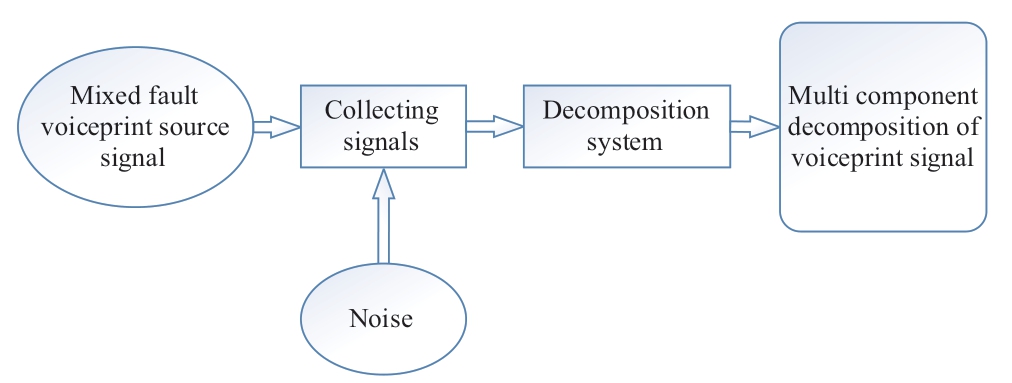
Fig.1 Separation model of multiple voiceprint information
The non-negative matrix decomposition algorithm is a multivariate statistical analysis method that can effectively decompose multi-component time-frequency signals into single component time-frequency signals.During the application process,by obtaining the decomposition matrix,a single component time-frequency signal can be obtained,which has clear physical significance.Therefore,this study provides a theoretical basis for the diagnosis of multiple faults in high-voltage circuit breakers.The mathematical expression for the decomposition model is as follows:
In the equation,B is the observation signal and is a known quantity.That is,B=[b1,b2,…,bN] is an observation signal matrix composed of signals and N is the number of samples.Each column of bi represents a sample,bi=[bi1,bi2,…,biM],where M is the sample dimension;Y is the voiceprint source signal of the high-voltage circuit breaker,which is composed of k unknown signal sources and is an unknown quantity,Yi=[yi1,yi2,…,yiN];A is called a mixed matrix,A=(aij)M×k,c is the noise vector.If c can be ignored without considering the impact of noise,or if the impact of noise is minimal,Equation (1) can be simplified as
The following will provide detailed principles and decomposition algorithms.
1.2 Principle and algorithm of non-negative matrix decomposition
The principle of non-negative matrix decomposition,proposed by Lee and Mitsufuji [21,23],has been widely applied in the engineering field.It is an important method for processing data that can solve the analysis problem of non-negative data and transform complex problems into simple problems,and has great application value.The theoretical idea is as follows: a non-negative matrix B can be decomposed into the product of two non-negative matrices,called the base matrix V and coefficient matrix E.The mathematical expression of its model is as follows:
where B∈RM×N.V∈RM×K.E∈RK×N,E=[e1,e2,…,eN].The column elements in matrix B represent the data samples,M is the sample dimension of the voiceprint signal,N is the number of samples,and K is the rank of the matrix.Due to min (M,N)≥K,dimensionality reduction of matrices can be achieved through calculations,thereby simplifying complex problems.
In practical applications of circuit-breaker detection in voiceprint information,a negative signal value is meaningless.Therefore,from the perspective of engineering applications and mathematical theory,it is feasible to use a non-negative matrix decomposition method for the voiceprint univariate decomposition of the detected multiple mixed-fault voiceprint signal matrix.By setting the collected voiceprint mixed-signal matrix to B,the single-component decomposition of the mixed-fault voiceprint signals can be achieved.In theory,there are exact solutions for the V and E matrices in Equation (3),but it is difficult to find them during the calculation process.Therefore,it is necessary to seek extremely equal approximate solutions such that both sides of Equation (3) are as equal as possible.To obtain an ideal decomposition matrix,it is necessary to establish rules for the iterative calculation process to achieve matrix decomposition.This section applies a matrix decomposition algorithm based on divergence deviation,which is more effective and simpler to implement than algorithms based on Euclidean distance and the maximum likelihood function[24-25].This is a type of gradient descent algorithm and its objective function is expressed as follows:

In Equation (4),bij is the element in matrix B,(VE)ik is the element in matrix VE,i∈[1,M],k∈[1,N].
The iterative update rule for the objective function in (4)is expressed as

In these equations ς1 and ς2 represent the selection of learning rate,Vik is the element of matrix V,and Eik is the element of matrix E.
The non-negative matrix decomposition method may result in non-unique solutions during the solution process,such as solutions V and E in Equation (3),which may have an invertible matrix C,making VC the solution of the equation,and C-1E the solution of the equation.This problem must be resolved for practical applications.According to current research,there are generally two solutions:one is to give appropriate initial values to non-negative matrices (this method is inconvenient to apply in a specific implementation),and the other is to add certain constraints to V and E.Therefore,this study selects the second method to complete the matrix decomposition of Equation (3),while ensuring uniqueness and accuracy.Certain constraint criteria are added to matrices V and H [26],and a new optimization objective function is obtained,as follows:
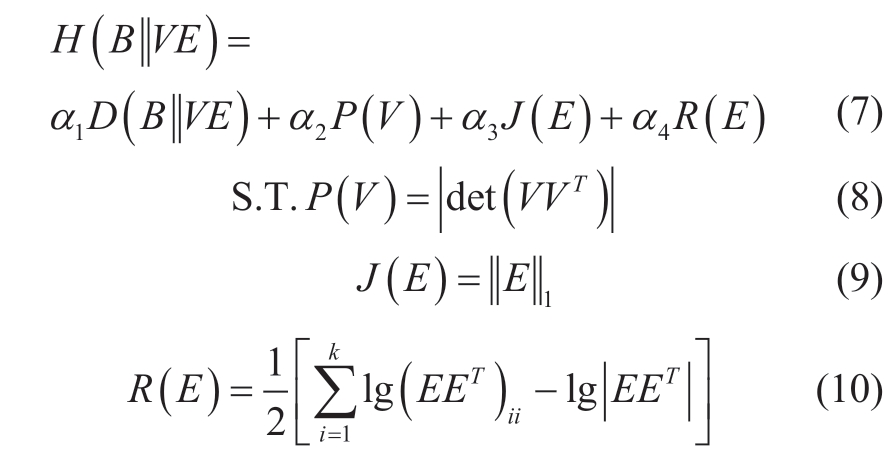
In Equation (7) α1,α2,α3,and α4 are the equilibrium parameters.Generally,α4=0.01,and d is a constant.When for any i,j,i≠j,R(E)obtains the minimum value of zero,E=[e1,e2,…,eN].The other parameter representations are as described above.
Minimizing![]() yields both V and E.In Equation(7),for V to be a convex function and for E to be a convex function,after obtaining the optimization objective function of Equation (7),the iterative update rules of equations (5)and (6) in the calculation change as follows:
yields both V and E.In Equation(7),for V to be a convex function and for E to be a convex function,after obtaining the optimization objective function of Equation (7),the iterative update rules of equations (5)and (6) in the calculation change as follows:
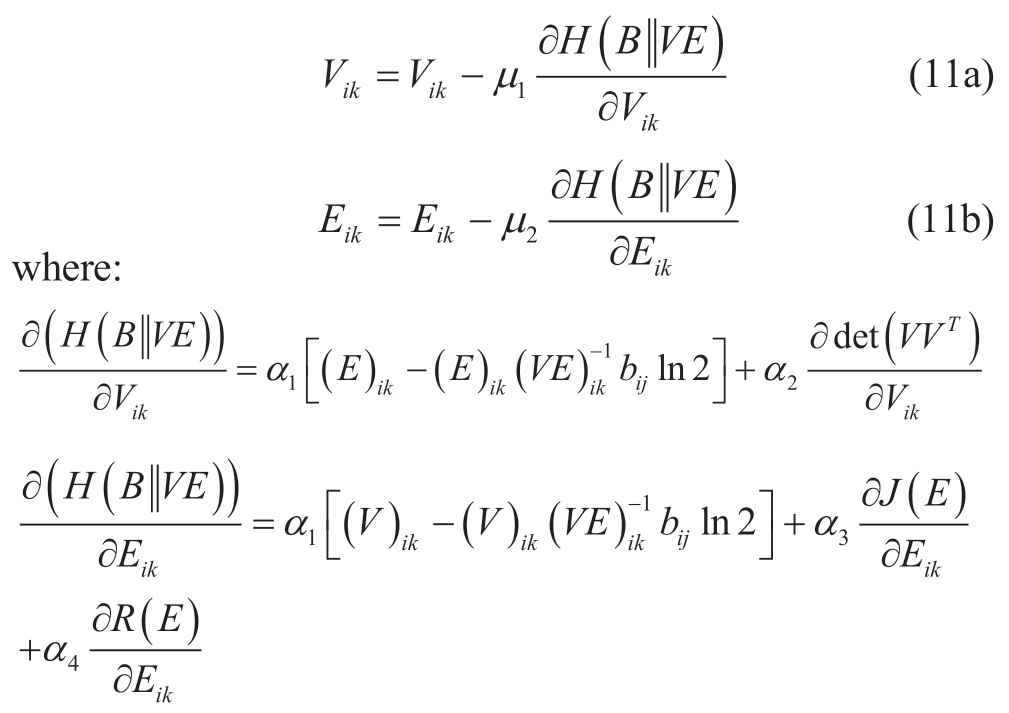

Among them,the learning rate coefficient is determined according to the following rules:
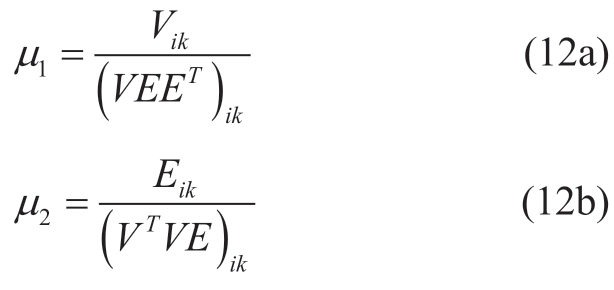
The iterative update rules for the source signal can be obtained by substituting Equations (11) and (12) into Equation (7).According to the optimization objective function given in Equation (7),after each iteration,the negative elements in V and E are set to zero,and the column vectors in V are normalized.When the final value is calculated to be less than a small threshold,the calculation terminates and is considered convergent,resulting in unique decomposition matrices V and E.The general steps for algorithm implementation are as follows:
Step 1.Initialize matrices V0 and E0 and normalize the column vectors of matrix V0.The initial iteration was set to t=0.
Step 2.Iterate matrix V,with the iterative rules described in (9),while normalizing matrix V,as follows:
Step 3.Iterate matrix E with iteration rules according to(9).
Step 4.Update the number of iterations and set t=t+1,until convergence.
Step 5.Reconstruct the base matrix V and coefficient matrix E to obtain the decomposed signal.
2 Analysis on the sound pattern of highvoltage circuit breakers during operation
Mechanical faults in circuit breakers include body faults,operating mechanism faults,loose firmware,and jamming.Body faults are mostly caused by gas leakage,which has adverse effects on the insulation and arc extinguishing ability of the circuit breaker,whereas iron core jamming faults are often caused by spring jamming,fatigue,loose bolts,etc.,resulting in abnormal opening and closing conditions.Most loose fasteners have loose bolts,which may lead to gap faults.To detect faults early,effective detection methods must be developed to determine the operating status of circuit breakers,which is important in the field of circuit breaker fault diagnosis.Monitoring the sound pattern information of circuit breakers to determine their operating status is an effective fault diagnosis method.The opening and closing sound pattern data contain rich information and have a high signal-to-noise ratio that can be used to diagnose faults.When a circuit breaker malfunctions,there may be a single fault or multiple faults that occur simultaneously.If multiple faults occur,the voiceprint data becomes more complex.If a commonly used deep-learning algorithm is used to train it directly,it is difficult to extract the corresponding features.Therefore,an approach that first decomposes the voiceprint data of multiple faults into variables can be adopted.Multiple faults are decomposed into components containing a single-fault feature,and the fault features are then extracted,ultimately completing the fault diagnosis.The variable decomposition of multiple faults is an extremely important step and is the main research topic of this study.
During actual operation,there may be interference from background noise (such as singing of birds or wind sounds).Extensive data analysis has shown that there is a significant difference between the spectral characteristics of the background noise and the voiceprint information emitted by the circuit breaker.Therefore,the influence of background noise was disregarded in this experiment.
3 Experimental simulation system and calculation analysis
3.1 Hardware design of voiceprint monitoring device
the voiceprint monitoring device primarily comprised an MSP chip,a program download interface on its left side,a chip reset circuit,three dial switches,and an external circuit.Within the device,the slave sampling circuit stands out because of the distinct power requirements of its operational amplifiers for both audio and magnetic field sections.Consequently,the slave power module is divided into two parts.One segment produces a positive power supply by utilizing a MOS transistor (CJ3401) and a voltage regulator (BL8565),along with its accompanying circuits.The other segment generates both positive and negative power supplies using a voltage regulator (LM27762) and its peripheral circuits,ensuring the efficient and reliable operation of the entire voiceprint monitoring system.
The voiceprint sampling circuit included a reference voltage chip,programmable instrumentation amplifier(AD8231ACPZ),and an operational amplifier(OPA365AIDR).The principle is to convert a sound signal into an analog voltage signal that fluctuates at 1.2 V through the eardrum vibration of an acoustic sensor (microphone sensor).The differential voltage signal was amplified using a programmable operational amplifier (AD8231ACPZ)and finally inverted using an operational amplifier(OPA365AIDR) before being input into the main control chip.
3.2 Signal conditioning circuit design
The conditioning circuit for the voiceprint signal is shown in Fig.2,which amplifies the sensor signal through a proportional operation circuit to achieve matching with the input of the data acquisition card.A limiting circuit is added to the back end of the operational amplifier of the proportional operation circuit,so that the signal output to the data acquisition card is limited to (-5 V,+5 V).
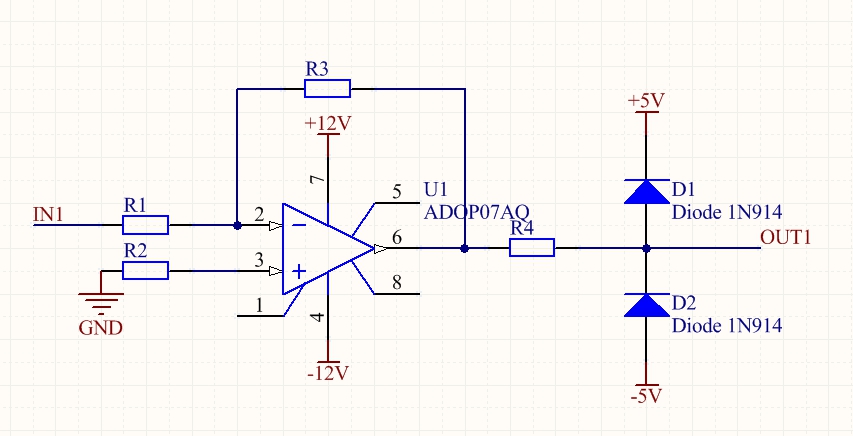
Fig.2 Conditioning circuit
Similarly,the signal conditioning circuit used for designing current signals also limits the signal to (-5 V,+5 V).
3.3 Power settings
Considering the application scenarios of the device,two power supply methods were adopted: 1.External AC power supply;2.Built-in lithium battery.The first scenario is suitable for the continuous monitoring of circuit breakers in intensive care (on a daily basis).The second scenario is suitable for the short-term diagnostic analysis of circuit breakers.In this study,the second method,which uses a built-in lithium battery,was adopted.
3.4 Integrated design of the device
The online voiceprint monitoring device uses a TI MSP430FR6989 chip to process the sampling signal.As shown in Fig.3,the system structure diagram includes the MSP and its peripheral circuits,sampling circuit,positive and negative power generation modules,detection circuit,and LoRa wireless communication module.
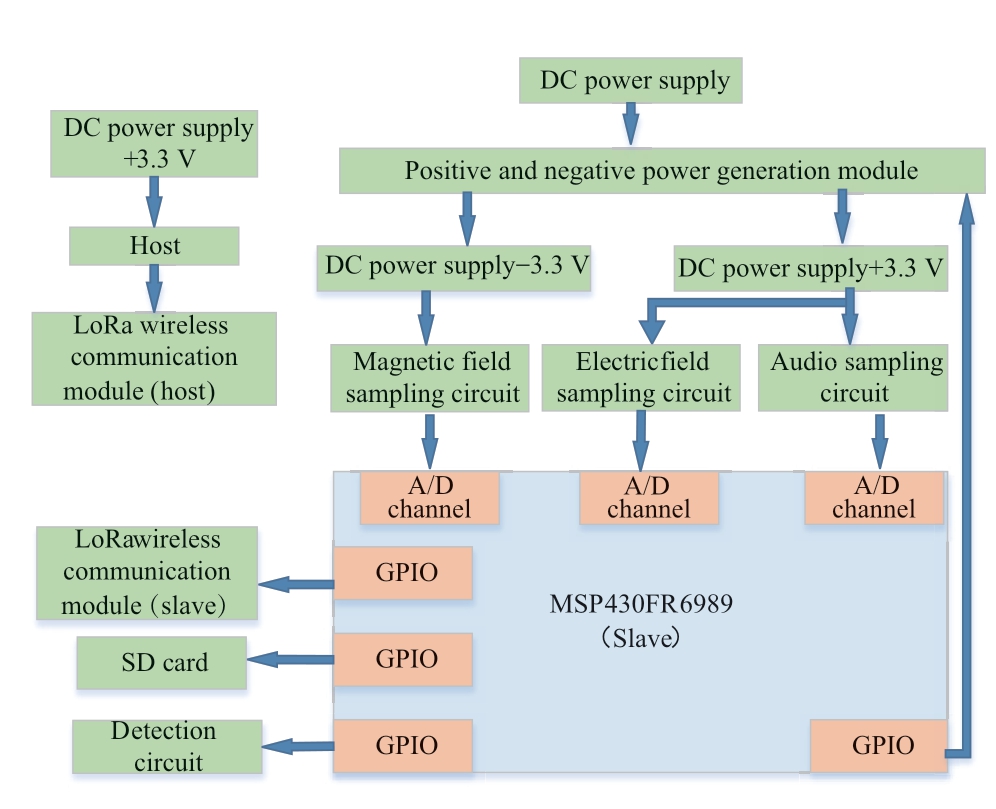
Fig.3 Structure diagram
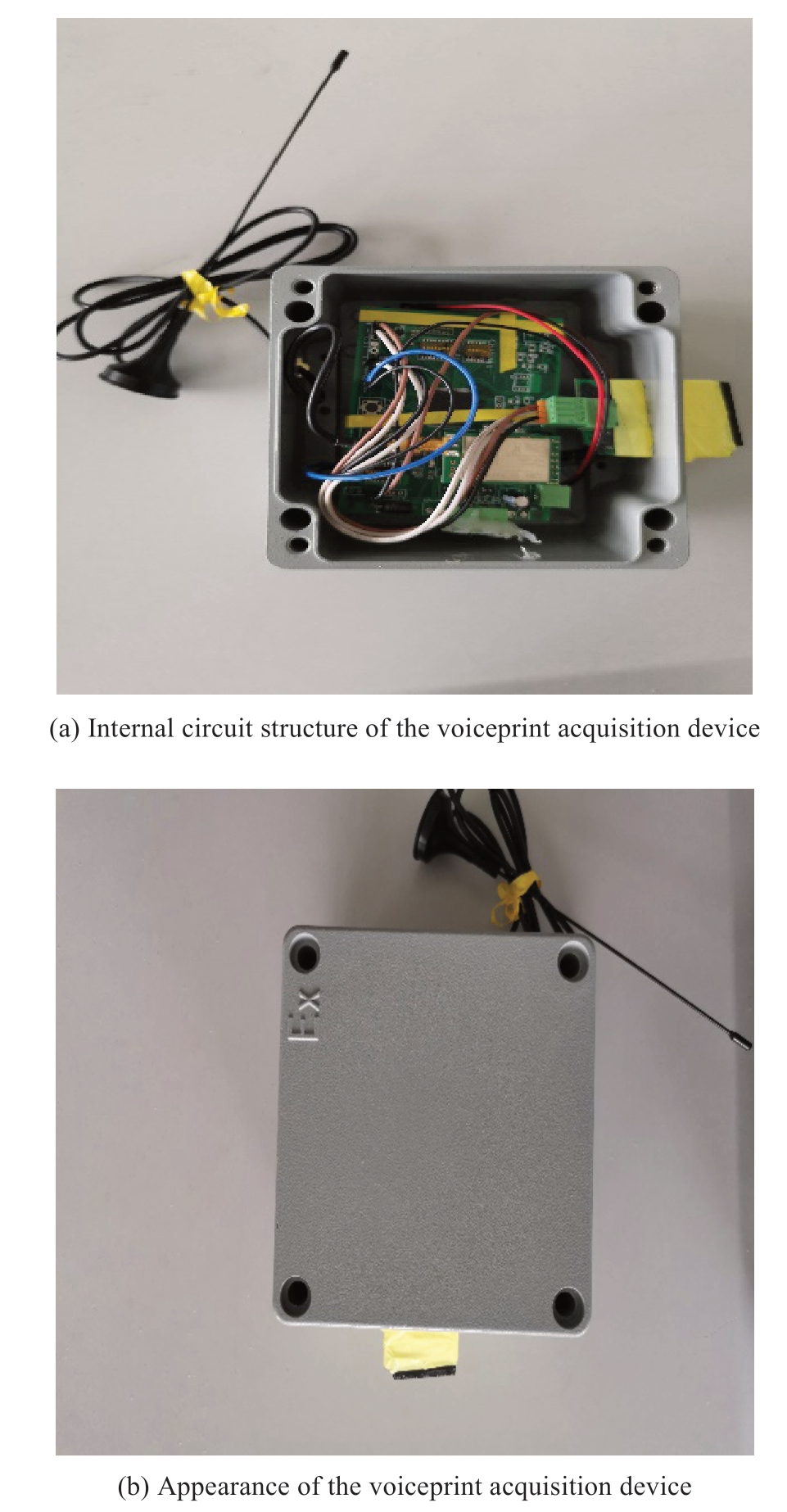
Fig.4 Voiceprint acquisition device for high-voltage circuit breaker
3.5 Software and hardware implementation process
The non-negative matrix decomposition method presented in this paper was applied to decompose the voiceprint information of circuit breakers.The device developed in this study was based on the MSP430FR6989 chip,and a variable-sampling circuit was designed to analyze the collected voiceprint information of the opening and closing of the circuit breaker.The detailed software and hardware implementation steps are as follows:
1.Sampling process and circuit design of the machine.The slave sampling circuit included a high-voltage circuit breaker and audio sampling circuit.The audio sampling circuit consists of three reference voltage chips: LM385b,a programmable instrumentation amplifier (AD8231ACPZ),and an operational amplifier (OPA365AIDR).The principle is to convert a sound signal into an analog voltage signal that fluctuates at 1.2 V through the vibration of the eardrum using a sound-wave sensor (microphone sensor).Subsequently,the differential voltage signal was amplified by a programmable operational amplifier (AD8231ACPZ)and finally input to the main control chip by following the operational amplifier OPA365AIDR in the reverse direction.
2.Obtaining voiceprint information.Data were collected from the slave’s AD module and stored on an SD card.A digital signal processing (DSP) chip was used to preprocess the collected digital signals using MSP430FR6989.
3.Non-negative matrix decomposition of voiceprint information.The voiceprint information obtained from the SD card was exported,and non-negative matrix decomposition was performed on the voiceprint information of multiple faults in the computer.The specific decomposition process is provided in steps 1 to 5.
4 Experimental platform and scenario analysis
4.1 Construction of experimental platform
The fault information of the high-voltage circuit breaker was measured experimentally to verify the effectiveness of the proposed detection technology.Figure 4 shows the sound-pattern information collection device for the highvoltage circuit breaker.The selected circuit breaker was an LW30-126 magnetic column high-voltage circuit breaker.The test platform included a circuit breaker equipment,a sound-pattern acquisition device,and other auxiliary equipment.
The circuit breaker was an LW30-126 magnetic column high-voltage circuit breaker,which included opening and closing of the transmission parts.The voiceprint acquisition device is a self-developed device that includes voiceprint sensors,data storage cards,sound amplifiers,and logic circuits.
The developed device can be applied to the actual operation of circuit-breaker fault monitoring.Figure 4 shows a model of the high-voltage circuit breaker in the substation.The actual installation position of the substation is illustrated in Fig.5.Because the installation position of this voiceprint acquisition device was approximately 1.8 m away from the sound source of the circuit breaker opening and closing,the distance between the placement position of the voiceprint acquisition device and the circuit breaker during the test process was set to 1.8 m.
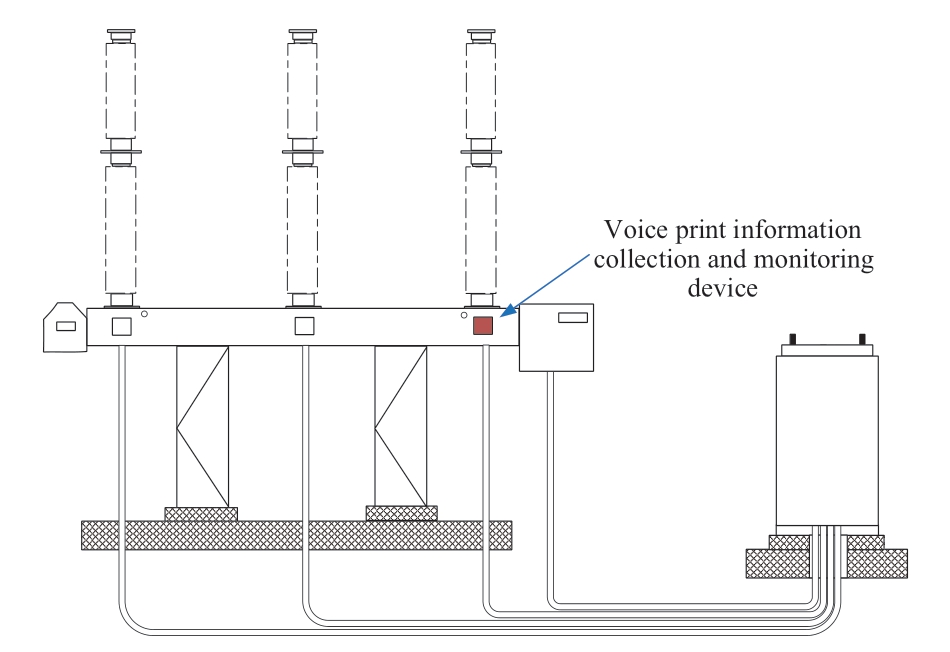
Fig.5 Installation location diagram of high-voltage circuit breaker voiceprint acquisition device
The aim of the experimental platform was to collect on/off voiceprint data information.The voiceprint sensor used was a PCB 378B02 voiceprint sensor,and the experimental monitoring platform is as shown in Fig.6.
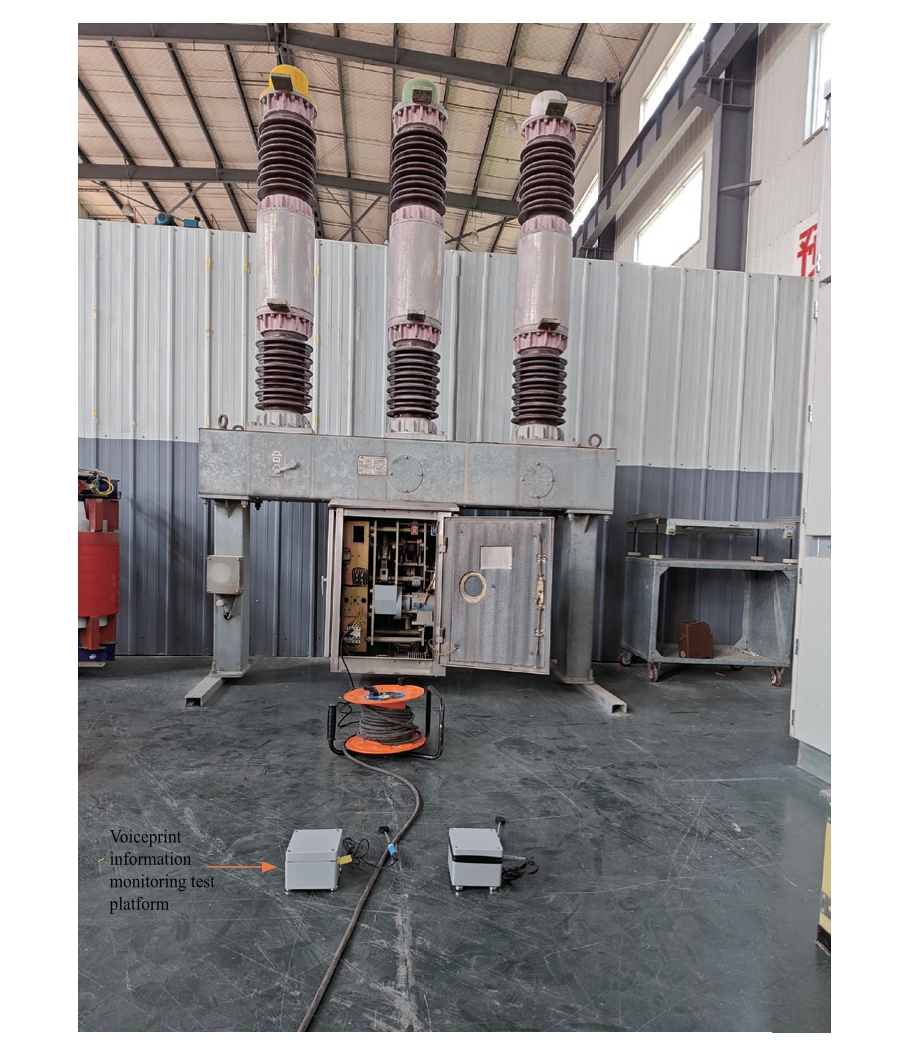
Fig.6 High-voltage circuit breaker voiceprint information monitoring test platform
The frequency of the voiceprint collection in the experiment was 10 kHz,and the types of fault sets included iron-core jamming and loose components.The simulation scheme for the iron core jamming fault was as follows: 50 g of objects was suspended on the opening and closing coils,the loosening gap was set to 4.5 mm,and the simulation plan for component loosening was as follows: the screws of the transmission bearing were loose as shown in Fig.7.
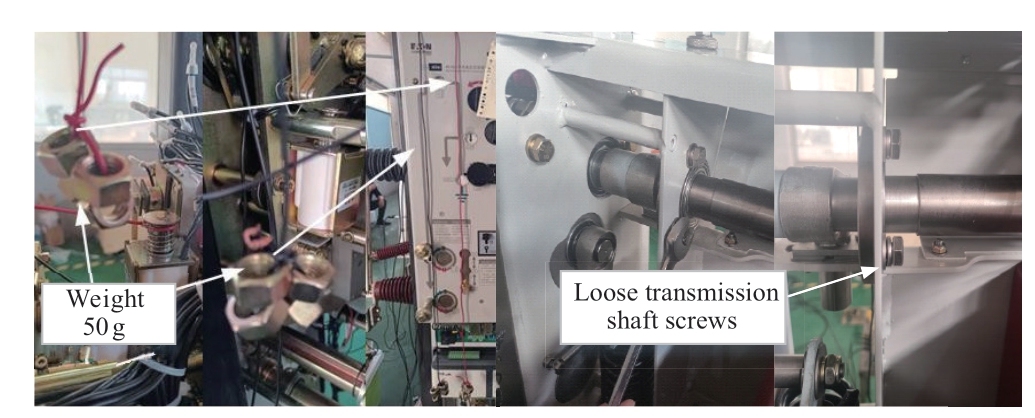
Fig.7 Fault simulation
Using the method and experimental platform employed in this study,the multiple-fault voiceprint information of high-voltage circuit breakers was collected and decomposed.To verify the accuracy and adaptability of the proposed decomposition method further,single-fault voiceprint signal was detected and collected.During the verification process,the variable decomposition results of the multiple-fault voiceprint signals were compared with those of the single-fault voiceprint signal.Therefore,when applying the experimental platform for detection and analysis,the verification conditions for collecting voiceprint information are divided into two types: 1) the collection of voiceprint information for multiple faults,and 2) collection of voiceprint information for a single fault.
4.2 Simulation case analysis
Case 1: Voiceprint information of multiple faults
The multiple-fault types were set as follows:simultaneous occurrence of component loosening and core jamming faults.The monitored time-domain waveforms and spectra are shown in Fig.8.
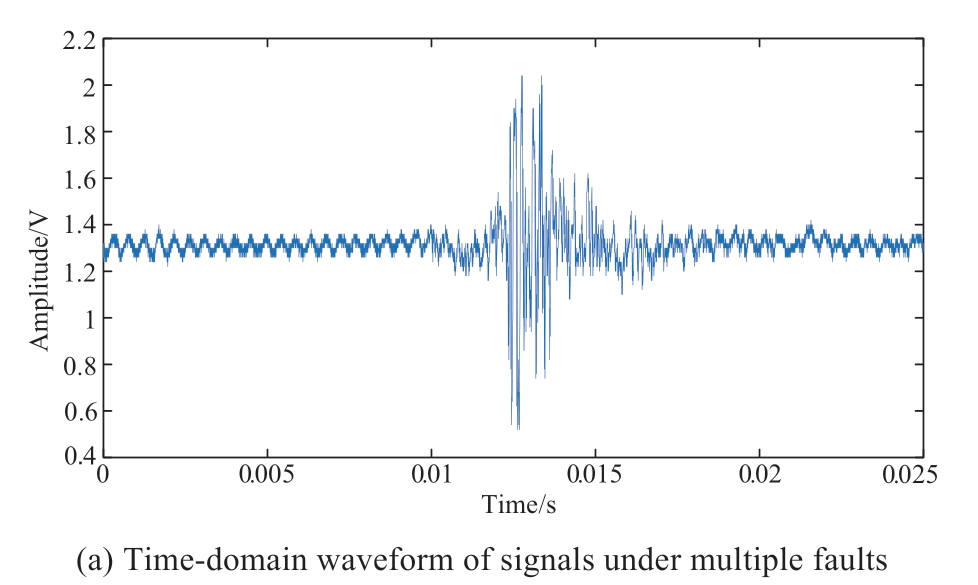
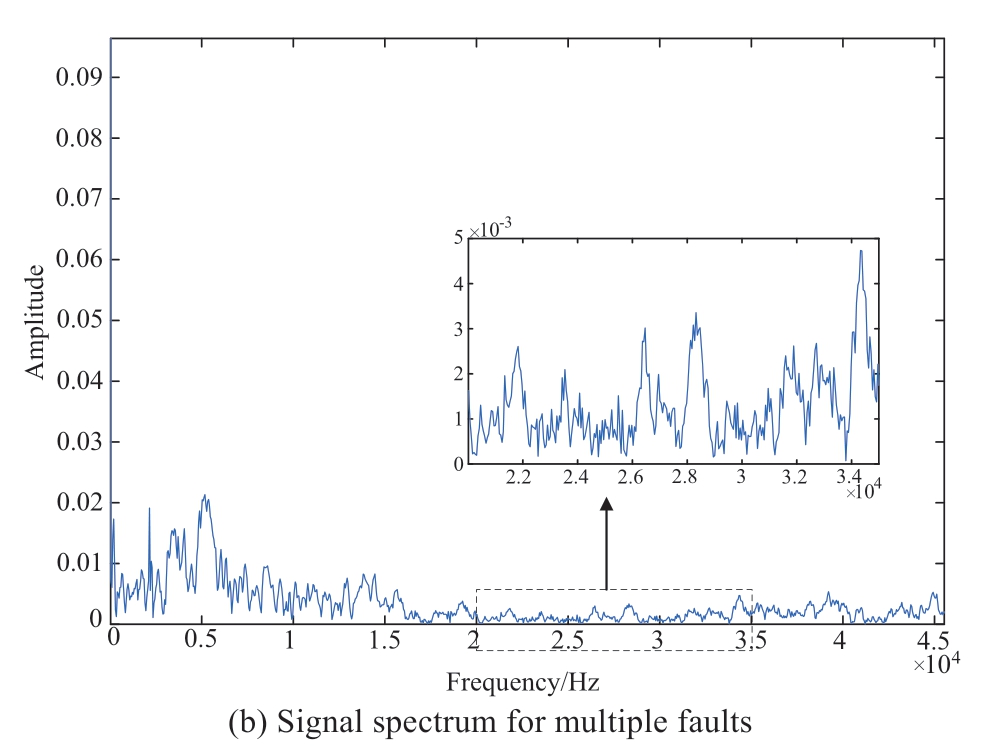
Fig.8 Time domain and spectral waveform of the acquired signal
The collected voiceprint information data in Fig.8 include information on two types of faults: component looseness and iron core jamming.From Fig.8 (a),it is evident that there is an impact component in the voiceprint signal,indicating that the circuit breaker experienced an abnormal operation.
Using the component decomposition method provided in,the voiceprint information of multiple faults is decomposed to obtain two sets of decomposed signals,as shown in Fig.9.From Fig.9,it can be observed that the frequency spectra of the two types of fault signals,namely component looseness and iron core jamming,were calculated using the method presented in this study.The frequency characteristics of each fault were identified and were in good agreement with the expected results of the theoretical analysis and calculations.
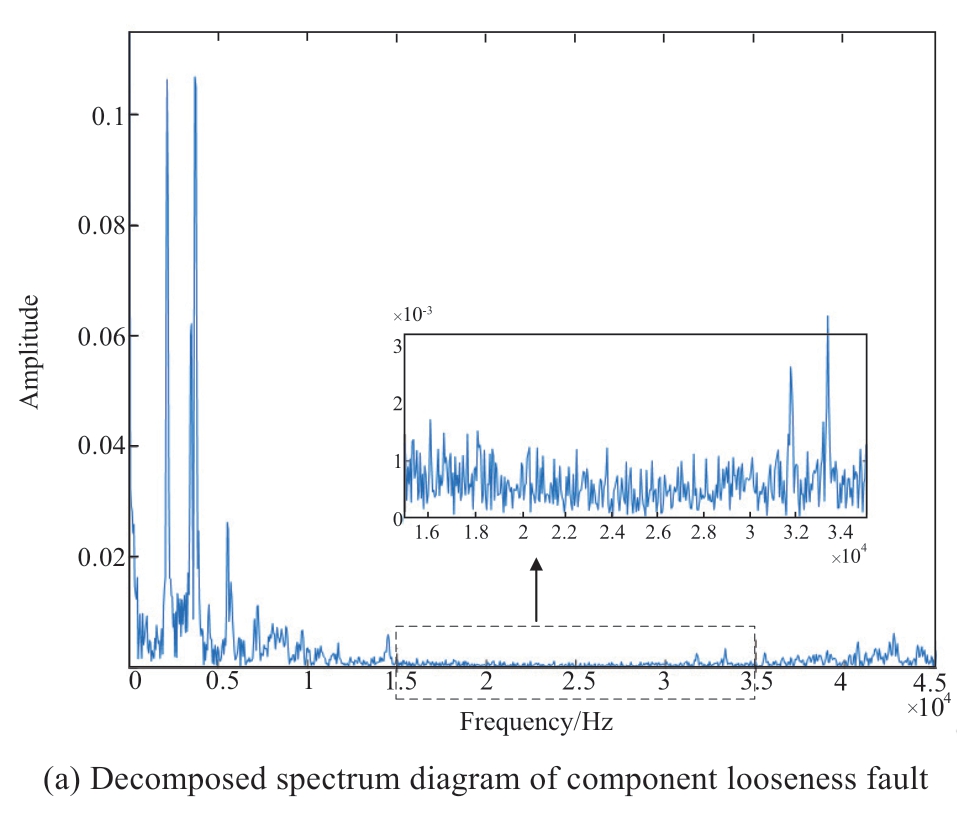
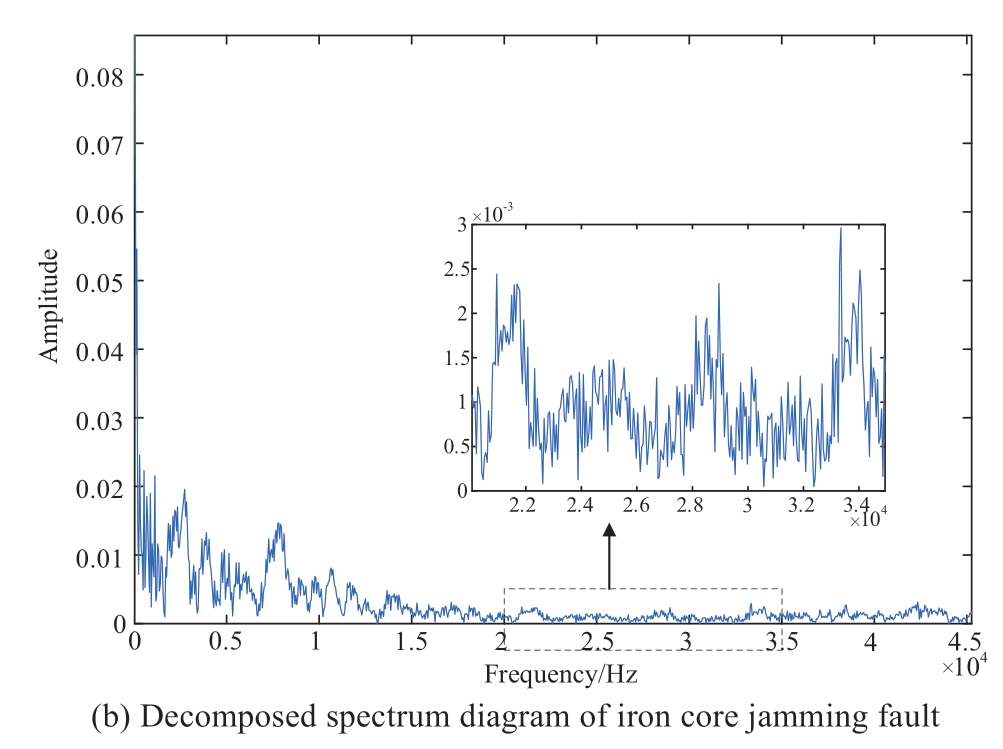
Fig.9 Spectral waveform of the separated signal
Case 2: Voiceprint information of a single fault
To further verify the correctness of the proposed method for identifying multiple-fault component decomposition signals and for the multiple-fault types in Condition 1,a single fault was set on the circuit breaker,and the fault voiceprint information was collected to compare the results of component decomposition under multiple-fault conditions with the voiceprint features under single-fault conditions to verify the effectiveness of the component decomposition method.Single-fault types were set as follows: loose components and jammed iron cores.The monitored timedomain waveforms and spectra are shown in Figs.10 and 11,respectively.
The frequency spectra of a single-component loose fault in Figs.9 (a) and 10 (b) are very similar,retaining the spectral characteristics of this type of fault.Therefore,if multiple faults occur,fault features can be extracted from Fig.10 (a) to achieve the purpose of identifying the fault.Similarly,the frequency spectra of a single fault and an iron core jamming fault in the decomposed component in Figs.9 (b) and 11(b) are very similar,and both retain the spectral characteristics of this type of fault.
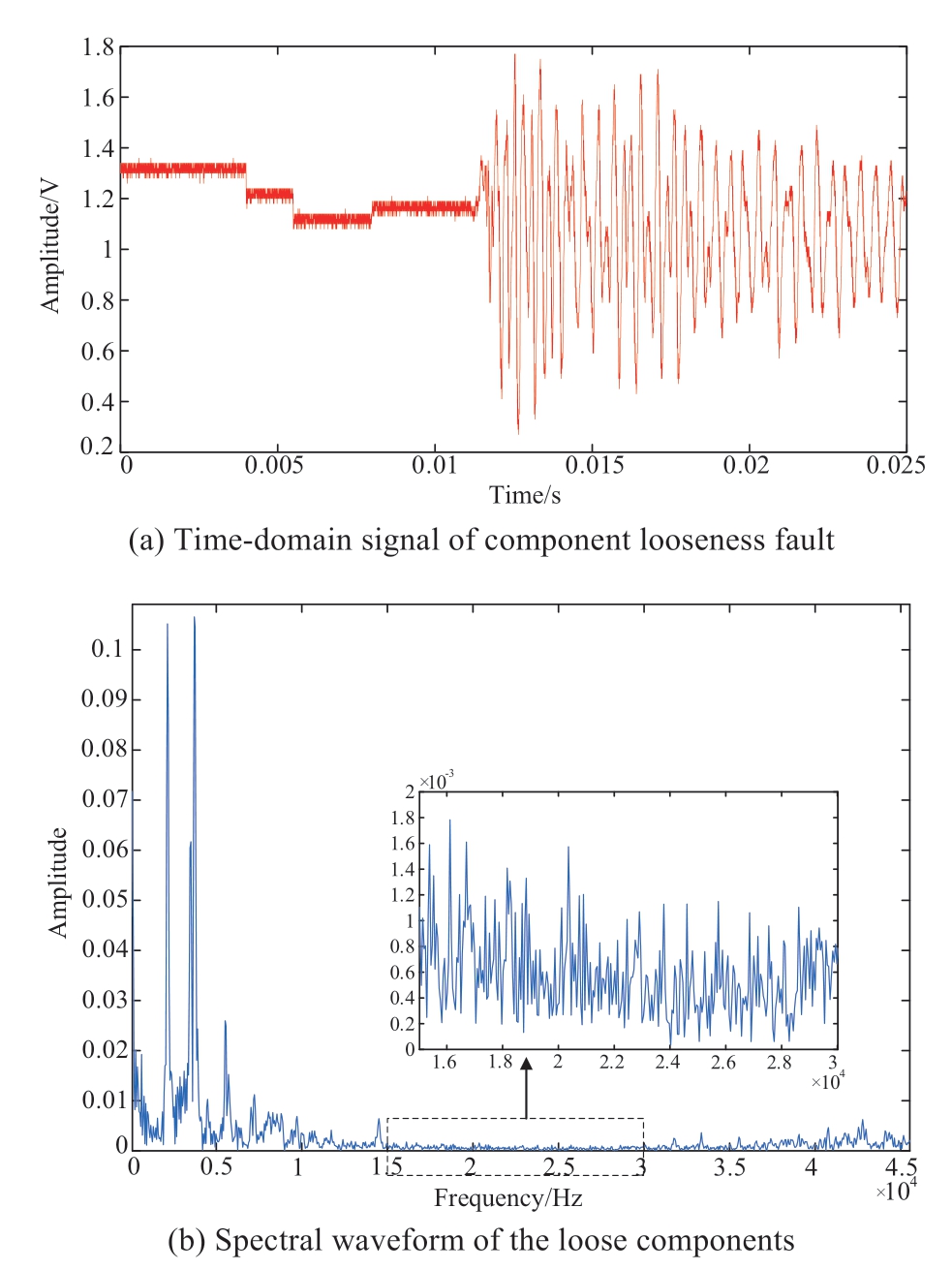
Fig.10 Signal waveform of component loosening fault under working Condition 2
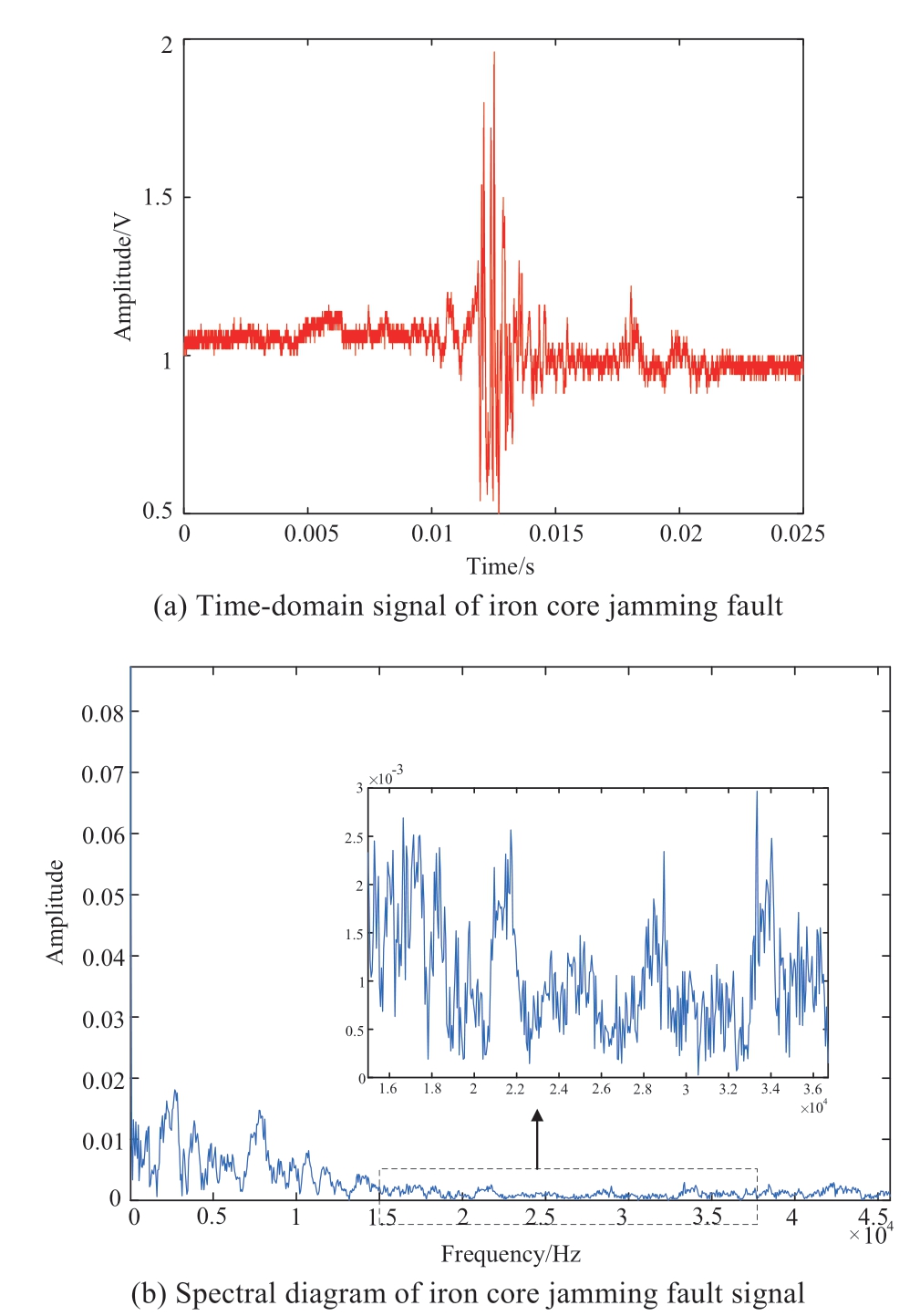
Fig.11 Signal waveforms of iron core jamming fault under working Condition 2
The fault-type spectrum waveforms obtained from Figs.9,10 (b),and 11 (b),as well as the spectrum obtained from component decomposition and the spectrum of a single fault actually detected,accurately capture the spectral characteristics of that type of fault,effectively achieving fault identification.The accuracy and efficiency of the proposed multi-fault component decomposition method were thus verified.
4.3 Performance comparison of different methods
To validate the advantages of the non-negative matrix decomposition method mentioned in the text,we analyzed multiple faults in Case 1.The basic non-negative matrix decomposition,empirical mode decomposition [14],and improved non-negative matrix decomposition methods presented in this paper were used to process the original voiceprint signal.The performances of the different algorithms were compared and analyzed,and the required calculation time and signal-to-noise ratio were used as evaluation indicators [27],as shown in Table 1.
Table 1 Performance comparison of different methods
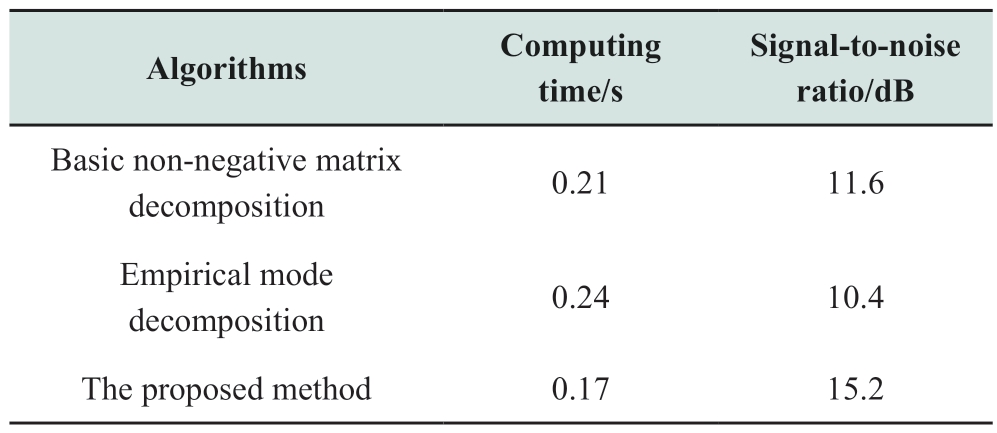
As shown in Table 1,the proposed method required less computation time and had a higher signal-to-noise ratio.The larger the signal-to-noise ratio,the better the separation effect between the source and separated signals.This indicates that the proposed signal decomposition method demonstrated superior performance.
5 Conclusions
During the opening and closing of high-voltage circuit breakers,the generated voiceprint information contains numerous state features.By collecting and analyzing this voiceprint information,an important reference can be provided to monitor the status and diagnose faults in the circuit breakers.This study adopted a multivariate decomposition method to investigate the component decomposition problem of multiple-fault voiceprint information that may occur during the operation of highvoltage circuit breakers.The main conclusions drawn are as follows:
1) When multiple faults occur in high-voltage circuit breakers,accurate diagnosis is challenging.This study proposes a theoretical method for fault decomposition that decomposes the voiceprint information of multiple faults into individual components,thus providing a theoretical basis for diagnosing multiple faults in circuit breakers.
2) The voiceprint acquisition device developed in this study can effectively obtain the voiceprint information of circuit breaker opening and closing,verifying the feasibility of the application of multiple-fault voiceprint information decomposition technology in high-voltage circuit breaker fault diagnosis.
3) A circuit breaker voiceprint information monitoring platform was constructed based on the proposed theoretical analysis technology.Voiceprint information was obtained through an experimental platform,and validation experiments were conducted accordingly.The experimental results verified that the proposed method exhibits high decomposition and accuracy.
In the future,in-depth research will be conducted on the practical application of multiple-fault signal decomposition and feature extraction technology,and the device will be applied to actual operating substations,providing a reference for high-voltage circuit breaker fault monitoring technology.
Acknowledgements
This study was supported by the State Key Laboratory of Technology and Equipment for Defense against Power System Operational Risks (No.SGNR0000KJJS2302137),the National Natural Science Foundation of China (Grant No.62203248),and the Natural Science Foundation of Shandong Province (Grant No.ZR2020ME194).
Declaration of Competing Interest
We declare that we have no conflicts of interest.
References
[1] Guan Y G,Yang Y W,Zhong J Y,et al.(2018) Review on mechanical fault diagnosis methods for high-voltage circuit breakers.High Voltage Apparatus,54(7): 10-19(in Chinese)
[2] De Oliveira A C,da Costa E G,Serres A J R,et al.(2019)Radiometric monitoring technique for high-voltage circuit breakers.IEEE Transactions on Power Delivery,34(4): 1656-1665
[3] Yang Y G,Guan Y G,Chen S G,et al.(2018) Mechanical fault siagnosis method of high voltage circuit breaker based on sound signal.Proceedings of the CSEE,38(22): 6730-6737
[4] Mei F,Pan Y,Zhu K D,et al.(2017) On-line hybrid fault diagnosis method for high voltage circuit breaker.Journal of Intelligent &Fuzzy Systems,33(5): 2763-2774
[5] Yang Q Y,Ruan J J,Zhuang Z J,et al.(2019) Condition evaluation for opening damper of spring operated high-voltage circuit breaker using vibration time-frequency image.IEEE Sensors Journal,19(18): 8116-8126
[6] Feizifar B,Usta O (2019) A novel arcing power-based algorithm for condition monitoring of electrical wear of circuit breaker contacts.IEEE Transactions on Power Delivery,34(3): 1060-1068
[7] Chen L,Wan S T,Dou L J (2022) Improving diagnostic performance of high-voltage circuit breakers on imbalanced data using an oversampling method.IEEE Transactions on Power Delivery,37(4): 2704-2716
[8] Wu Z S,Zhang Z L,Wang W L,et al.(2022) Fault diagnosis algorithm of transformer and circuit breaker in traction power supply system based on IoT.Energies,15(23): 8812
[9] Dou L J,He Y L,Wan S T,et al.(2022) Detecting method of high voltage circuit breaker spring fatigue based on vibration signal.Transactions of China Electrotechnical Society,37(24):6420-6430(in Chinese)
[10] Hou L,Chang Z,Cai Y et al (2023) Design of tripping result detection device for release of low voltage DC circuit breaker.Electrical Measurement &Instrumentation,60(4): 155-159,175(in Chinese)
[11] Chen Y Y,Zhang D,Xue H X (2021) Intelligent fault diagnosis method of rolling bearing based on ensemble empirical mode decomposition.Chinese High Technology Letters,31(5): 559-568(in Chinese)
[12] Pi Y,Liu H K,Li Q (2021) Fault diagnosis of breaker by flexible film array pressure sensor.High Technology Letters,31(8): 836-843
[13] Xue H T,Ding D Y,Li R C,et al.(2023) Feature extraction method based on component weighted reconstruction and sparse NMF for bearing compound faults of in-wheel motor.Journal of Mechanical Engineering,02-15,https://kns.cnki.net/kcms/detail//11.2187.TH.20230214.14440.01.html
[14] Li C N,Yu G,Fu B C,et al.(2019) Fault separation and detection for compound bearing-gear fault condition based on decomposition of Marginal Hilbert Spectrum.IEEE Access,7:110518-110530
[15] Wang J J,Gao R X,Yan R Q (2014) Integration of EEMD and ICA for wind turbine gearbox diagnosis.Wind Energy,17(5):757-773
[16] Miao D (2019) Research on fault diagnosis of high-voltage circuit breaker based on support vector machine.International Journal of Pattern Recognition and Artificial Intelligence,33(6): 1959019
[17] Liu H L,Chang G Y,Zhao S T,et al.(2023) Circuit breakers state identification method based on tracing spring deformation process and recurrence quantitative analysis of vibration signals.Transactions on China Electrotechnical Society,04-27.https://doi.org/10.19595/j.cnki.10006753.tces.230201.
[18] Zhao K,Wang F,Yang Y W,et al.(2018) Mechanical condition evaluation of high voltage circuit breaker based on the features fusion and optimization of different signals.High Voltage Apparatus,54(4): 14-19(in Chinese)
[19] Wan S T,Li C,Dou L J,et al.(2019) Study on the signal feature extraction and classification of high voltage circuit breaker based on vibration signal and current signal.Journal of North China Electric Power University (Natural Science Edition),46(4): 31-38,53(in Chinese)
[20] Zhao L H,Ji Y W,Wu Y Z,et al.(2021) LM-BP fault diagnosis algorithm for spring operating mechanism of high voltage circuit breaker based on motor current.Electrical Measurement&Instrumentation,https://kns.cnki.net/kcms/detail/23.1202.th.20210917.2207.004.html.
[21] Lee D D,Seung H S (1999) Learning the parts of objects by nonnegative matrix factorization.Nature,401: 788-791
[22] Zhang P L,Wang H G,Zhang L,et al.(2013) Feature extraction for engine fault diagnosis by utilizing adaptive multi-scale morphological gradient and non-negative matrix factorization.Journal of Vibration Engineering,26(6): 944-950(in Chinese)
[23] Mitsufuji Y,Uhlich S,Takamune N,et al.(2019) Multichannel non-negative matrix factorization using banded spatial covariance matrices in wavenumber domain.IEEE/ACM Transactions on Audio,Speech,and Language Processing,28: 49-60
[24] Lv Z G (2012) A non-negative matrix factorization method research and application in blind source separation.Wuhan University of Science and Technology
[25] Li Y Q,Cichocki A,Amari S I (2004) Analysis of sparse representation and blind source separation.Neural Computation,16(6): 1193-1234
[26] Sekiguchi K,Bando Y,Nugraha A A,et al.(2020) Fast multichannel nonnegative matrix factorization with directivityaware jointly-diagonalizable spatial covariance matrices for blind source separation.IEEE/ACM Transactions on Audio,Speech,and Language Processing,28: 2610-2625
[27] Bofill P,Zibulevsky M (2001) Underdetermined blind source separation using sparse representations.Signal Processing,81(11): 2353-2362

Scan for more details
Received:23 October 2023/Revised: 15 December 2023/Accepted:9 January 2024/Published: 25 April 2024
 Zhaoxing Ma
Zhaoxing Ma
mazhaoxingapple@126.com
Yongrong Zhou
zhouyongrong@sgepri.sgcc.com.cn
Hao Chen
pingfengma@126.com
Ruihua Wang
wangruihua@qut.edu.cn
2096-5117/© 2024 Global Energy Interconnection Development and Cooperation Organization.Production and hosting by Elsevier B.V.on behalf of KeAi Communications Co.,Ltd.This is an open access article under the CC BY-NC-ND license (http://creativecommons.org/licenses/by-nc-nd/4.0/).
Biographies

Yongrong Zhou received his Bachelor degree from Southeast University,Nanjing,2003.He is working at NARI Group Co.,Ltd.,Nanjing.His research interests are mainly focused on power system and its automation.

Zhaoxing Ma, Ph.D.in 2013,currently working in Qingdao University of Technology.He is engaged in the research on power system analysis,operation,and control.

Hao Chen, Ph.D.is currently working as a researcher-level senior engineer at the State Grid Nanjing Power Supply Company.He is engaged in research on intelligent operations and the inspection of substations.

Ruihua Wang, Ph.D.in 2016,is currently working in Qingdao University of Technology.Her research interests include cloud control,hybrid systems,positive systems,fuzzy systems,tracking control,filtering and their applications.
(Editor Yanbo Wang)
